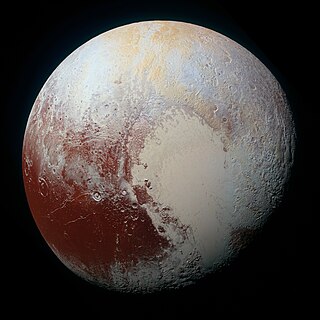
The International Astronomical Union is an international non-governmental organization (INGO) with the objective of advancing astronomy in all aspects, including promoting astronomical research, outreach, education, and development through global cooperation. It was founded on 28 July 1919 in Brussels, Belgium and is based in Paris, France.

Planetary nomenclature, like terrestrial nomenclature, is a system of uniquely identifying features on the surface of a planet or natural satellite so that the features can be easily located, described, and discussed. Since the invention of the telescope, astronomers have given names to the surface features they have discerned, especially on the Moon and Mars. To found an authority on planetary nomenclature, the International Astronomical Union (IAU) was organized in 1919 to designate and standardize names for features on Solar System bodies.
In astronomy, stars have a variety of different stellar designations and names, including catalogue designations, current and historical proper names, and foreign language names.
In ancient times, only the Sun and Moon, a few stars, and the most easily visible planets had names. Over the last few hundred years, the number of identified astronomical objects has risen from hundreds to over a billion, and more are discovered every year. Astronomers need to be able to assign systematic designations to unambiguously identify all of these objects, and at the same time give names to the most interesting objects, and where relevant, features of those objects.

Tumāḍir bint ʿAmr ibn al-Ḥārith ibn al-Sharīd al-Sulamīyah, usually simply referred to as al-Khansāʾ was a 7th-century tribeswoman, living in the Arabian Peninsula. She was one of the most influential poets of the pre-Islamic and early Islamic periods.
al-Khansa was a 7th-century female Arabic poet.
Al-Khansaa was an online women's magazine launched in 2004 by a Saudi branch of al-Qaeda.

A dwarf planet is a small planetary-mass object that is in direct orbit around the Sun, massive enough to be gravitationally rounded, but insufficient to achieve orbital dominance like the eight classical planets of the Solar System. The prototypical dwarf planet is Pluto, which for decades was regarded as a planet before the "dwarf" concept was adopted in 2006.

The International Astronomical Union (IAU) defined in August 2006 that, in the Solar System, a planet is a celestial body that:
- is in orbit around the Sun,
- has sufficient mass to assume hydrostatic equilibrium, and
- has "cleared the neighbourhood" around its orbit.
Qatada ibn al-Nu'man (c.581–c.644) was one of the companions of the Islamic prophet Muhammad and a member of the Ansar.

Matisse is an impact crater on the southern hemisphere of Mercury. Matisse takes its name from the French artist Henri Matisse, and it was named by the IAU in 1976.
Dorayd bin Al Summah was a pre-Islamic warrior, knight and poet of the Hawazin tribe. He was also the chief of the Banu Jusham bin Muawiya, or the modern day Al-Qthami clan of the tribe of Otaibah. Historians have cited that he contributed to more than a hundred battles for his tribe. By the time of the rise of Islam, he was already an old man and remained a pagan.

Al Hilal a is multipurpose district in central Doha. It is home to the Doha Mall, the city's first shopping centre. Prior to the 2010 census, Zone 41 comprised Al Hilal West, but the zone was later transferred to Nuaija. Many sizable residences are situated here, and the Embassy of India, Doha formerly had its headquarters here.
The International Astronomical Union (IAU) established a Working Group on Star Names (WGSN) in May 2016 to catalog and standardize proper names for stars for the international astronomical community. It operates under Division C – Education, Outreach and Heritage.
The 2019 Lebanese Challenge Cup was the 7th edition of the Lebanese Challenge Cup. The competition included the teams placed between 7th and 10th in the 2018–19 Lebanese Premier League, and the two newly promoted teams from the 2018–19 Lebanese Second Division. The first matchday was played on 19 July, one day prior to the start of the 2019 Lebanese Elite Cup. Tadamon Sour are the defending champions, having won the 2018 final. The final was held on 24 August, with Bourj beating Salam Zgharta 2–0 to be crowned champions.

Rabelais is a crater on Mercury. It has a diameter of 154 kilometres. Its name was adopted by the International Astronomical Union (IAU) in 1976. Rabelais is named for the French writer François Rabelais.

Shevchenko is a crater on Mercury. Its name was adopted by the International Astronomical Union (IAU) in 1976, for Ukrainian poet Taras Hryhorovych Shevchenko.










